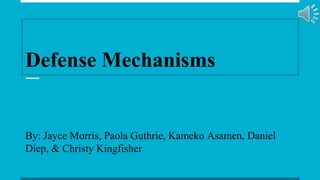
Animal Biology Presentation
- 1. Defense Mechanisms By: Jayce Morris, Paola Guthrie, Kameko Asamen, Daniel Diep, & Christy Kingfisher
- 2. Introduction Evolution has allowed prey to develop anti-predator adaptations to help them in their struggle against predators These defense mechanisms can take on many forms such as camouflage, mimicry, bodily adaptations (spines&armor), chemical defenses, or by sacrificing body parts just to name a few Prey are constantly having to select for more effective adaptations since their predators are selecting for better mechanisms to capture their prey this is the result of coevolution of the two The phyla that will be discussed include arthropoda, chordata, and echinodermata
- 3. Sea Cucumber • Kingdom: • Animalia • Phylum: • Echinoderm • Class: • Holothuroidea
- 4. Sea Cucumber (Echinoderm) When in stress this animal typically buries itself deeper into the sand, but when in extreme stress this animal expels its guts and some of its respiratory trees this is called, Evisceration. This mechanism allows the animal to scare its predator off
- 5. Sea Cucumber (Echinoderm) • Three main structures weaken over a period of about 1-3 minutes, become soft and transparent, and eventually separate from their attachments. These are the basal part of the tenticles, the attachment points of the introvert retractor muscles to the longitudinal muscles (there are 10 of these), and the junction of intestine andcloaca. The softening is a state-transformation of the collagen components in the tissue. • Parts eviscerated include the gut, associated heamal vessels, tentacles, and introvert (the dexterous anterior extensible portion of the body wall). The gut tears away from the mesenteries that suspend it within the coelomic cavity. • Most of the gonad stays behind. Only strands of gonad tangled in the gut are eviscerated. The paired respiratory trees and cloaca also remain (although they may be expelled in other species) • The introvert changes from being firm and opaque to being soft and translucent. The body-wall muscles contract and the increased pressure forces coelomic fluid and viscera into the introvert. It enlarges like a balloon and soon ruptures, expelling the fluid and visceral • This takes about 20 minutes, with final detachment of the tentacles and introvert sometimes taking as long as 12 hours. • The anterior rupture seals, at first by muscular contraction and then by healing as a plug of connective-tissue.
- 6. Texas Horned Lizard Kingdom: Animalia Phylum: Chordata Class: Sauropsida
- 7. Texas Horned Lizard • This lizard is able to stay camouflaged perfectly with their skin showing the same texture and color as the surrounding desert environment they live in. • They also have spiny armor to deter any predator from grabbing them and can also puff up their body to double their size. • This lizard’s coolest ability is to squirt an aimed stream of blood from the corners of its eyes for a distance of up to 5 ft. This not only confuses predators, but the blood is also mixed with a chemical that has a foul-taste to canine predators such as wolves, coyotes, and domestic dogs.
- 8. Texas Horned Lizard In extreme cases to defend itself, the horned lizard shoots blood out of its eye by two constricting muscles that line the major veins around it. When these muscles contract, they cut off the blood flow back to the heart, while it continues to flow into the head. This floods the ocular sinuses with blood, building pressure, and causing them to bulge. By further contracting of these muscles in a rapid manner, the pressure increases even more, eventually rupturing the thin sinus membranes. The result is a jet stream of blood that can shoot from the eye socket, a process known as auto-hemorrhaging.
- 9. Bombardier Beetles The Scientific classification are Kingdom: Animalia Phylum: Arthropoda Class: Insecta
- 10. Bombardier Beetles Have a unique defense mechanism. When Bombardier Beetles feel threatened they spray a boiling liquid called benzoquinone to predators. Benzoquinone is stored in the abdomen of the beetle.
- 12. Conclusion We have discussed only 3 of many different types of defense mechanisms in animals. These defenses are as diverse as the animals in which they are found To review: Sea Cucumber: uses evisceration to defend itself Texas Horned Lizard: uses camouflage, spines, body enlargement and squirting blood/ chemical defenses Bombardier Beetle: uses a chemical defense by spraying Benzoquinone
- 13. References Davis, Mark. "Predation and Defense." - Biology Encyclopedia. Web. 30 Nov. 2015. <http://www.biologyreference.com/Po-Re/Predation-and- Defense.html>. Evans, A. V. National Wildlife Federation. Bombadier Beetles. New York, NY , 2007. news, Delhidaily. Bombardier beetle's butt is a gun. 1 May 2015. http://bugguide.net/node/view/16725 "Eyes Squirt Blood: Horned Lizard." AskNature. Web. 30 Nov. 2015.